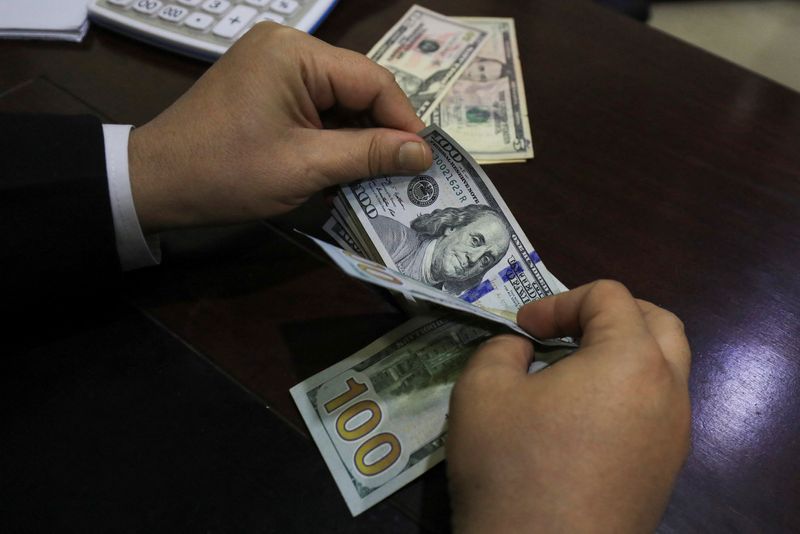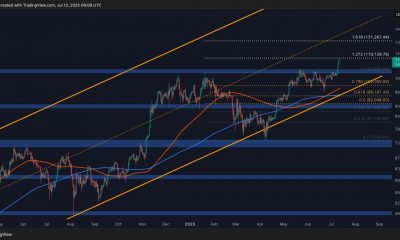Forex
Yen gains after intervention warning, dollar dips


© Reuters. A trader counts U.S. dollar banknotes at a currency exchange booth in Peshawar, Pakistan January 25, 2023. REUTERS/Fayaz Aziz
By Karen Brettell
NEW YORK (Reuters) – The yen strengthened on Monday after Japan’s top currency diplomat warned against speculators trying to weaken the currency, while China’s yuan gained on suspected selling of dollars by state-owned banks.
That helped to send the U.S. dollar lower against a basket of currencies, after it reached a one-month high on Friday.
Masato Kanda, Japan’s vice finance minister for international affairs, said that weakness in the Japanese currency did not reflect fundamentals, in the latest warning about the currency’s “big slide” against the dollar.
“He’s clearly putting traders on alert for signs of intervention,” said Karl Schamotta, chief market strategist at Corpay in Toronto.
The dollar was last down 0.11% on the day at 151.26 Japanese yen, after hitting a four-month high of 151.86 on Friday. It is within striking distance of a 32-year low of 151.94 per dollar hit in Oct. 2022.
Traders are watching the level around 152 for signs of possible intervention, although Schamotta noted that the government may not step in unless volatility also picks up.
“Implied volatility does continue to grind lower across most major currencies so this is a supportive environment for the carry trade – we should continue to see speculators borrow in yen and other low yielders, and invest in the emerging market high yielders,” he said, adding “that could continue to put downward pressure on the yen.”
The Japanese currency has dropped despite the Bank of Japan hiking interest rates out of negative territory last week.
gained 0.37% in the offshore market after dropping to a four-month low on Friday, propped up by suspected selling of dollars by state-owned banks and a strong official guidance set by the country’s central bank.
The Chinese currency has been pressured by growing market expectations of further monetary easing to prop up the world’s second-largest economy.
The was last down 0.23% at 104.19, after hitting 104.49 on Friday, the highest since Feb. 16.
Federal Reserve Chair Jerome Powell said last week that the U.S. central bank remains on track for rate cuts this year, despite stickier than expected inflation in January and February.
Some Fed officials including Atlanta Fed President Raphael Bostic, however, have expressed concern about persistent inflation and stronger-than-anticipated economic data. Bostic said on Friday that he now expects just a single quarter-point interest rate cut this year instead of the two he had projected.
The personal consumption expenditure (PCE) price index for February due on Friday is the next major release for further clues on Fed policy. The data will come as other markets including stocks and bonds are closed for the Good Friday holiday, which may reduce foreign exchange trading volumes.
The euro was last up 0.27% at $1.0835. Sterling rose 0.36% to $1.2643.
Bets for a June rate cut by the European Central Bank and the Bank of England (BoE) have risen substantially after the Swiss National Bank became the first major central bank to lower borrowing costs last week and BoE Governor Andrew Bailey told the Financial Times that rate cuts “were in play” this year.
Elsewhere, the Australian dollar rose 0.40% to $0.6540.
climbed 6.9% to $67,923. It has fallen from a record high of $73,803.25 on March 14.

 Forex3 years ago
Forex3 years agoForex Today: the dollar is gaining strength amid gloomy sentiment at the start of the Fed’s week

 Forex3 years ago
Forex3 years agoUnbiased review of Pocket Option broker

 Forex3 years ago
Forex3 years agoDollar to pound sterling exchange rate today: Pound plummeted to its lowest since 1985

 Forex3 years ago
Forex3 years agoHow is the Australian dollar doing today?

 Cryptocurrency3 years ago
Cryptocurrency3 years agoWhat happened in the crypto market – current events today

 World3 years ago
World3 years agoWhy are modern video games an art form?

 Commodities3 years ago
Commodities3 years agoCopper continues to fall in price on expectations of lower demand in China

 Economy3 years ago
Economy3 years agoCrude oil tankers double in price due to EU anti-Russian sanctions



























